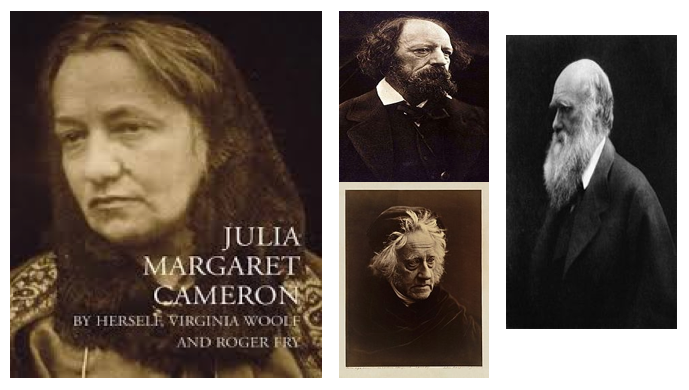[Originally published as part of my Column “Green Cardamoms “ in Shillong Times, Canvas, page 3].
Shoot Tennyson And Darwin
Author: Gaurangi Maitra

photo credits: www.issuu.com & www.wikipedia.org
Memory tags: Reading about Julia Margaret Cameron
In our school bags, on our bookshelves, in our archives and in our minds, each subject is neatly separated in time, space and perception. So it becomes incomprehensible that Tennyson a poet and Darwin a scientist were shot by the same lens and same photographer. So widely divergent are poetry and science when not connected in time and space, they seem to belong to separate epochs of human history. History of science checks us into a larger common space that does not alienate science from human society.
One lens in the hands of a lady by named Julia Margaret Cameron captured scientists Charles Darwin, Joseph Dalton Hooker and John Herschel; artists GF Watts and William Holman Hunt, novelists William Makepeace Thackeray and Lewis Carroll; thinkers John Ruskin and Thomas Carlyle; poets Henry Wadsworth Longfellow, Edward Lear, and Robert Browning in portrait photographs. She did not set her subjects among symbols of greatness or of their profession. Against stark, cropped backgrounds she projected great minds of the 19th century England focusing on persona rather than person blurring the lines between thinker and thought, in soft focus on albumin prints. She did not open shop in the conventional sense, instead she drew out the famous from intellectual circles and her salons and charmed them into posing for her.
Her portfolio of the nearly 1000 photographs began when she received a camera in 1863 from her daughter as a present on her 48th birthday. By then, she had moved to England from Calcutta, had six children and was at the heart of high brow salon in Little Holland house, London. After all, in pedigree conscious England, she was sister in law to Henry Toby Princep, ex Director of the East India Company who owned Little Holland House and wife to Charles Hay Cameron, retired jurist and member of the law Commission in Calcutta. Painters, poets, writers and scientists gathered in this salon. When the Camerons went on holiday to the Isle of Wright and visited Tennyson’s Farringford House, they were so charmed by the place that they bought an adjoining property in 1860 naming it Dimbola after their coffee estate in Ceylon, now Sri Lanka. Farringford and Dimbola became the focus of the celebrated on an Isle where celebrities swarmed. In 1868 Charles Darwin had accepted Julia Margaret Cameron’s invitation and spent the summer at Dimbola with family and friends that included Joseph Dalton Hooker. So Darwin, Hooker and Tennyson met in the summer of’68 over tea and conversation. She took four fine portraits of Darwin and a rather severe one of Hooker. Darwin liked his own portraits but of Hooker’s which hung in his home, he wrote“ but you look down so sharp at me that I shall never be bold enough to wiggle myself out of any contradiction.”(It would be quite at home in Harry Potter’s Hogwarts School). Darwin paid her handsomely for his own portraits and this she would use to ease the debt from their failing coffee plantations. Tennyson, her neighbour and friend sat patiently through many a slow exposure and experimental set up before her standard sliding box camera. Her unconventional approach had Tennyson call one photograph of himself, “the dirty monk”. What she conceived as “the high priest of learning” while composing John Herschel’s photograph was startling and was even used as a representation of bad hair today. Being well acquainted with her fresh style of soft focus, close up, large format print of subjects often dressed in special costumes, Tennyson requested her to illustrate his Idylls of the King. She roped in family and friends and photographed them over 180 exposures in costumes to suit the motifs in the book. The final folio opened with a portrait of Tennyson himself with one large lavish original photograph for each of its twelve chapters.
Today when every phone carries a camera, it is no big deal for a variety of people to be shot by one famous photographer. But in the early days of photography her subjects, themes and style were rare originals that have remained some of the most valuable of Victorian photographs. They speak to us of a time when photography evolved along with the Charge of the Light Brigade and Origin of Species.
Main resources:
- Dimbola Museum & Galleries
- Metropolitan Museum of Art, Getty Museum
- Heilbrunn Timeline of Art History
- Wikipedia
- www.darwinproject.ac.uk entry 6327 & 6333
- news.bbc.co.uk/dna/place-lancashire/plain/A2773299
